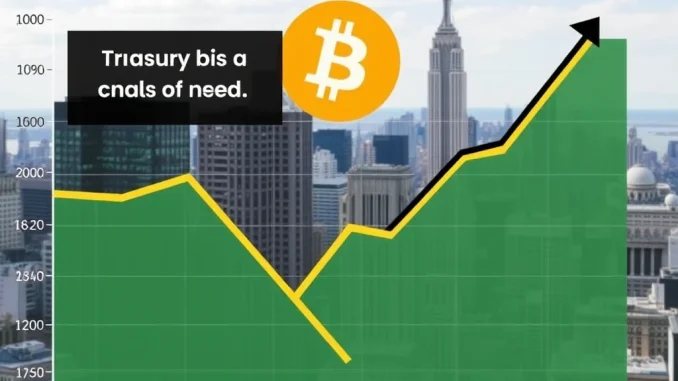
Buckle up, crypto enthusiasts! April has brought a whirlwind of change to the Bitcoin ETF landscape. Just when we thought institutional adoption was in full swing, a dramatic shift has occurred. Spot Bitcoin ETFs in the U.S. have experienced a staggering $800 million outflow this month, according to recent CoinDesk data. Yes, you read that right – millions flowing out, not in. This unexpected turn of events raises crucial questions about institutional sentiment and the broader market outlook. What’s behind this sudden change of heart, and what does it mean for the future of Bitcoin and the crypto market? Let’s dive deep into the details.
Why Are Institutions Dumping Bitcoin ETFs for US Treasuries?
The million-dollar question (or rather, the $800 million question!) is: why the sudden exodus from Bitcoin ETF Outflows? The answer, it seems, lies in a confluence of factors, primarily driven by a flight to safety amid growing economic uncertainties. Institutions, traditionally known for their cautious approach to risk management, appear to be prioritizing stability over potential high-growth assets like Bitcoin in the current climate. Here’s a breakdown of the key drivers:
- Rising Recession Risks: Whispers of a potential recession have grown louder in recent weeks. Economic indicators are sending mixed signals, and the fear of a downturn is prompting institutions to de-risk their portfolios. In times of economic uncertainty, assets perceived as ‘safe havens’ become increasingly attractive.
- Tariff-Driven Volatility: Global trade tensions and tariff-related uncertainties are injecting significant volatility into the markets. This volatility makes riskier assets like Bitcoin less appealing to institutions seeking predictable returns and capital preservation.
- Attractive Yields on US Treasuries: Simultaneously, U.S. Treasury bills are offering increasingly attractive yields. Government bonds are considered among the safest investments globally, and when their yields become competitive, they present a compelling alternative to riskier assets. Recent Treasury auctions have witnessed strong demand, indicating robust confidence in government debt.

The Allure of US Treasuries: A Safe Harbor in Stormy Markets
When market clouds gather, US Treasuries often become the beacon of stability for institutional investors. Why are these government bonds so favored during times of economic turbulence?
- Ultimate Safety: Backed by the full faith and credit of the U.S. government, Treasury bills are considered virtually risk-free. In a world of uncertainty, this guarantee of principal repayment is paramount.
- Liquidity and Accessibility: The U.S. Treasury market is the most liquid bond market globally. Institutions can easily buy and sell large volumes of Treasuries without significantly impacting prices, ensuring quick access to capital when needed.
- Predictable Returns: Unlike volatile assets like Bitcoin, Treasury yields offer a relatively predictable stream of income. This predictability is highly valued by institutions that need to meet specific return targets and manage cash flow effectively.
- Portfolio Diversification: Treasuries play a crucial role in portfolio diversification. Their low correlation with equities and other risk assets helps to reduce overall portfolio volatility and enhance risk-adjusted returns.
The current shift towards Institutional Investment in US Treasuries underscores a classic ‘risk-off’ sentiment prevailing in the market. Institutions are prioritizing capital preservation and stable returns over the potential for high growth, which is inherently associated with greater risk.
Decoding Market Volatility: Bitcoin’s Wild Ride and Institutional Nerves
Market Volatility is inherent in the cryptocurrency space, and Bitcoin is no stranger to dramatic price swings. While this volatility can be attractive to some traders seeking quick profits, it can be unsettling for large institutional investors with longer-term investment horizons and stricter risk mandates.
Here’s how market volatility is impacting institutional decisions:
| Factor | Impact on Bitcoin ETFs | Impact on US Treasuries |
|---|---|---|
| Increased Volatility | Reduces institutional appetite due to higher risk | Increases attractiveness as a safe haven |
| Economic Uncertainty | Triggers flight to safety, outflows increase | Demand rises, yields may become more attractive |
| Risk Aversion | Institutions reduce exposure to risk assets | Institutions increase exposure to safe assets |
The recent Bitcoin ETF outflows are a clear indication that institutional investors are currently prioritizing risk management in the face of heightened market volatility. They are seeking shelter in the perceived safety of US Treasuries, at least for the time being.
Recession Risks on the Horizon: A Catalyst for Conservative Investment Strategies?
The looming specter of Recession Risks is undoubtedly a major factor driving institutional investment decisions. While the global economy has shown resilience in some areas, concerns about slowing growth, persistent inflation, and potential interest rate hikes are fueling recessionary fears.
How do recession risks contribute to the shift away from Bitcoin ETFs?
- Economic Downturns and Risk Assets: Historically, during economic downturns, risk assets like equities and cryptocurrencies tend to underperform as investors become more risk-averse. Institutions often reallocate capital to safer asset classes in anticipation of or during a recession.
- Capital Preservation Focus: In a recessionary environment, the primary focus for many institutions shifts from maximizing returns to preserving capital. Safe-haven assets like US Treasuries become the preferred choice for achieving this objective.
- Reduced Risk Tolerance: Recession fears naturally lead to a reduction in risk tolerance across the board. Institutions become less willing to take on speculative investments and favor assets with a lower probability of capital loss.
What Does This Mean for Bitcoin and the Crypto Market?
The $800 million outflow from spot Bitcoin ETFs is a significant event, but it’s crucial to view it in perspective. It doesn’t necessarily signal a long-term abandonment of Bitcoin by institutions. Instead, it reflects a tactical shift in asset allocation in response to specific macroeconomic conditions.
Here are some key takeaways and potential implications:
- Short-Term Sentiment Shift: The outflows indicate a short-term cooling of institutional sentiment towards Bitcoin ETFs. This could put downward pressure on Bitcoin prices in the near term.
- Cyclical Market Behavior: Market cycles are a natural part of financial markets. Periods of risk aversion and flights to safety are often followed by periods of renewed risk appetite. As economic conditions evolve and market volatility subsides, institutional interest in Bitcoin and crypto assets could return.
- Long-Term Institutional Adoption Narrative: The long-term narrative of institutional adoption of Bitcoin remains intact. Bitcoin’s fundamental value proposition as a decentralized, digital store of value is still compelling. This current outflow may simply be a temporary detour in the broader adoption journey.
- Opportunity for Strategic Accumulation: For long-term Bitcoin bulls, periods of price weakness driven by institutional outflows can present opportunities for strategic accumulation. ‘Buy the dip’ remains a common mantra in the crypto space.
Conclusion: Navigating the Crypto Tides
The recent Bitcoin ETF outflows serve as a potent reminder of the dynamic and ever-changing nature of financial markets. Institutional investment decisions are heavily influenced by macroeconomic factors, risk sentiment, and the availability of alternative investment opportunities. While the shift towards US Treasuries may seem like a setback for Bitcoin ETFs, it’s crucial to recognize it as a tactical maneuver within a larger, evolving market landscape.
As market volatility subsides and economic uncertainties clarify, we may well see institutions returning to Bitcoin and other crypto assets. The fundamental drivers of crypto adoption – decentralization, digital scarcity, and innovative technology – remain powerful forces. For now, the crypto market is navigating a period of cautious sentiment, but the long-term potential of Bitcoin and blockchain technology remains undiminished. Stay informed, stay agile, and keep a watchful eye on the tides of the crypto market!



